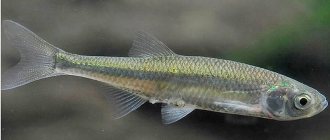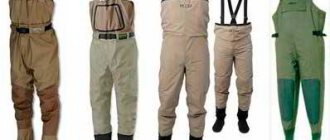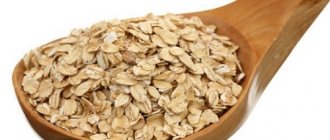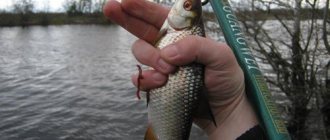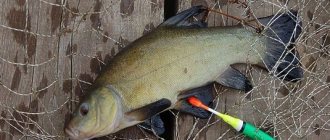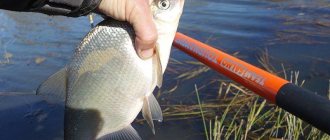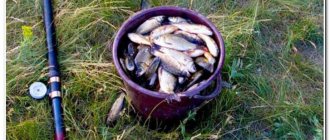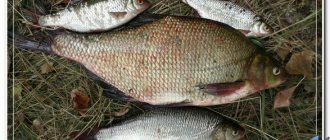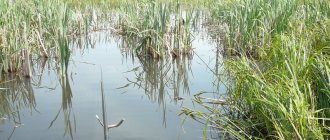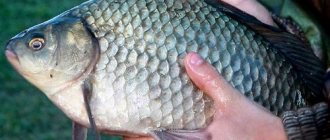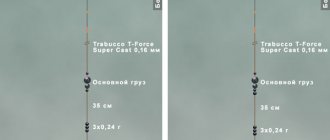Bleak can be used for live bait fishing, and due to its high fat content, it has a unique taste when fried or dried. Bleak fishing is most popular in March, April, May, and June, and the best tackle for such fishing is a float rod.
In this article you will learn how the tackle should be structured, which rod to choose for the best bleak fishing in spring and early summer, and you will also be able to watch a video of the fishing process.
Where to catch bleak
In search of food, the fish roams throughout the entire reservoir, so there are no difficulties in choosing a place to catch it; you only need convenient access to the water section.
plant thickets , preferring clean, open water. Natural timidity forces it on windless days not to approach the coastline closer than ten to fifteen meters, unless spawning has begun. During currents or during strong winds, waves create a certain safety, and a school of fish approaches the shoreline within the distance of a fishing rod.
For spring bleak fishing, small shallow waters and coastal places with a depth of no more than three meters, open to sunlight, are recommended.
Bleak behavior in spring
In the spring season, before the start of spawning, the fish begin to eat.
The bleak seeks to gain strength after winter in preparation for this event. During this period, both small fish and individuals that have managed to spawn can bite. With the beginning of March, bleak begins to actively take an interest in any bait. If the ice is strong enough, fishing begins there.
April for fishing is characterized by the fact that you have to look for a good place. This is done quickly, since bleak is characterized by noisy behavior, and its feeding places are easy to determine. From the first days of this month, bleak is preparing for spawning, which begins after the water warms up to fifteen degrees. Its bite lasts from sunrise until ten o'clock, then its activity decreases sharply, and only in the evening the fish becomes active again.
In May, the daily increase in water temperature causes the bleak to change tactics and slide down to depths of one and a half meters. But the fish continues to attack the bait greedily and confidently. Fishing in cold regions can continue from June until July.
Float rod equipment
The bleak is caught on a fishing rod. You can use light tackle, because the fish are not very large. For instant hooking, the rod test should be as light as possible.
The fishing rod for float fishing is taken as a fly rod. For casting at close and medium distances, rods of 3-4 meters are quite sufficient. The rod should be extremely light, up to 120 grams.
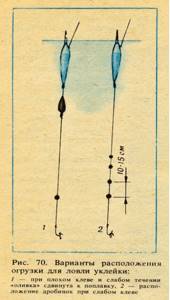
Options for loading a float when catching bleak on a float. 1 heavy pellet or several medium pellets. With a few medium bites, the bite is felt better when fishing in the current.
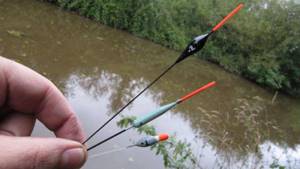
Floats for catching bleak

Loading and float underwater
The equipment must ensure smooth immersion of the nozzle into the water column. For this reason, the main requirements for it are light weight and sensitivity of the float. You must be prepared for the fact that it is quite difficult to control such tackle when casting to the required distance, especially in windy weather. Therefore, the fisherman must “feel” the fishing rod when equipping it, create excellent flight characteristics, so as not to experience problems when catching bleak.
Video on making float equipment for bleaching:
Float and weight
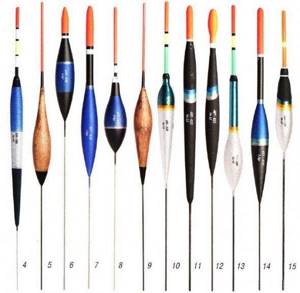
Click to enlarge. The total weight of the equipment should be light and acceptable for weather conditions and the length of the fishing rod. In calm weather, it is recommended to use equipment from 0.5 to 1 g , and in strong winds with a side direction, the weight of the equipment is increased to 2 g .
The float (5-8 cm, about 0.3 grams) is loaded as much as possible, only the small tip of its antenna remains above the surface of the water. Due attention is paid to loading, since the float should sink even with small bites.
The recommended float shape is spindle-shaped . It is better not to use other types with long antennas, since in the spring bleak is mainly caught off the coast.
fishing line
Many people use 0.1 mm fishing line. A thinner one will get tangled, and a thicker one will not allow the use of light equipment. If the bite is weak, it is allowed to use a leash that is thinner than the main line and does not exceed seven centimeters in length. This measure will allow you to instantly distinguish a bite.
Pin Hook from the owner is quite suitable Hook size chart 0.1mm, lb 6, 300m
Hook
For catching bleak in the spring, a hook with an elongated shank and a straight bend is best suited. A hook point that is concave inward will require more time to remove the bleak from the hook, and the fishing rate will decrease. Excessively thin hooks are also not suitable - the percentage of failures increases. Recommended room sizes are 18, 19 and 20.
Lures for catching bleak
Maggot is a classic bait for catching bleak in the spring.
In the spring, maggot works best for catching bleak. It is not only considered tasty for bleaking, but is also more convenient - one large larva can catch at least a dozen fish. To attract bleaks, they use not only white maggots, but also red and even yellow ones.
If the bleak is not biting too actively , use a large bloodworm as bait - it does not fly off the hook for long enough.
If there is no suitable attachment, the bleak is caught on bread crumb or dough. Such baits are bad because the fish eats them quickly or knocks them off completely.
catchable places
The best areas for fishing for bleak in the spring are narrow, shallow waters. Fishing for bleak in the spring takes place in places on the reservoir where trees or other vegetation will not interfere with the water warming up.
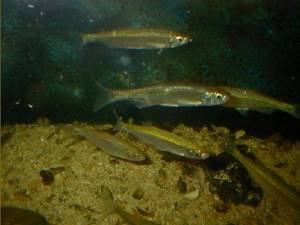
In addition, experienced fishermen pay attention to the fact that the wind blows towards the shore. So he drives the heated water right under the feet of the fisherman, and with it a lot of prey will come.
Fishing method and process
Bleak is caught using a plug or fly rod, depending on the fishing conditions. If bites are frequent, then the weight of the rod will quickly tire your hands, and the plug version will not be so good.
Some people catch bleak by fly fishing. The gear is quite complex; you need to know how to use it correctly. Bleak can also be found on bottom gear designed for large fish.
Still, the best option is considered to be a float rod for fishing from the shore.
Remember that bleaks are mainly interested in baits that are in motion. If the bait remains inactive for a long time, the fish will ignore it. To attract bleak, you should periodically drag the fishing rod to create the appearance of bait activity. To do this, the tackle is re-cast or lightly twitched with the rod tip.
The bite should be immediate, as the bleak quickly eats the maggot.
Feeding bleak
Fishing begins with scattering bait (two to three handfuls) at the intended fishing points to form an area for bleak accumulation.
As a rule, it forms a circle of half a meter in diameter around the float. The complementary food is scattered with a damp hand so that it does not stick to the palm. The first portion is sent away, the remaining portions are gradually brought closer to you. The scattering is carried out in small portions to create cloudy columns. For warm water, the fishing depth is set to 30-40 centimeters, and in cool weather the fish prefers to stay near the bottom or at half-water. As a rule, the flock approaches within 5–15 minutes, but sometimes active biting begins already from the first cast.
In order for the bleak to more actively take the bait , the frequency of feeding increases - the cloudy column should settle to the bottom slowly. If there is no bite, or the fish activity is weak, change the bait or fishing depth. It is very important to find the level at which the flock stands.
If there is a forced break in fishing , associated, for example, with replacing equipment, you should not interrupt feeding - the school of fish may move to the side. To prevent this, tie a piece of dried bread to a rope and let it float on the surface of the water.
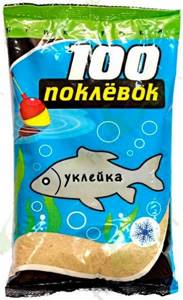
Strawberry flavor is a classic for catching bleak
You can buy bait at the store or prepare it yourself. In the first case, compositions are selected that are intended specifically for bleaking or for other small fish that stay in the upper water layers.
If you decide to prepare
complementary foods with your own hands , there is a fail-safe recipe :
- Semolina and bran are mixed in a ratio of 1 to 3.
- You can add a small amount of crushed bread crumb to the resulting mass.
- For every three liters of complementary food, one glass of milk is poured in to create the necessary turbidity, which attracts bleak.
- Soak the resulting porridge with water from a reservoir.
There is a simpler option, suitable for preparing complementary foods directly on the pond - fresh white bread is mixed with sand from the reservoir in which you will be fishing.
Lure
Bleak is a curious, gambling and fickle fish. To keep her attention for a long time, you will have to work. Of course, the main tool in this work will be bait.
Our main goal is to create the most stable, clearly visible cloud in the water column. To do this, the mixture must contain more small, very slowly sinking particles. It is desirable that the bait in the water produces a lot of turbidity, forming this very cloud. The result is achieved by adding light, muddy clay and special paint. Powdered milk also creates excellent turbidity, leaving a “protein trace” clearly visible to fish in the water.
In the assortment of large bait companies you can find specialized mixtures for catching bleak. But if you don’t have one at your disposal, it doesn’t matter. Take the simplest roach bait, sift it through a blood sieve, removing all large particles (you don’t have to throw them away, but add them later to another bait), add a couple of handfuls of “Belgian coconut” and a couple of tablespoons of white, yellow or red bait paint. Some vanilla or fruit flavoring wouldn't hurt. If you do not have such additives, replace them with fine bran, finely ground sunflower cake and dry milk.
There are two approaches to mixing bleak bait.
According to the first, the bait is made dry, just enough so that you can form a lump and throw it to the fishing point. It should break on the surface or crumble literally at the very beginning of the dive.
Unfortunately, this bait does not muddy very well, even if it contains a lot of paint. However, it may turn out to be indispensable in cases where the bleak still remains at a great distance from the shore and has to be caught with “longer” gear. In addition, such bait may be preferable when specifically hunting for larger bleak.
Read: Pike fishing. Float rod
Much more often, a different approach is used, in which the bait is moistened to the state of thick sour cream, so that a lump the size of a cherry can be formed from this “puree”. In this case, a powerful cloud that does not settle for a long time is formed in the water, which attracts and retains bleak well.
Most often, you don’t even need to add live food to the bait; Of course, if you don’t spare a little bloodworm or small maggot (kicks) for bleaking, it will only be better.
Feeding rate and fishing tactics
At the beginning of fishing, you need to feed almost continuously so that the cloud hangs in the water column constantly. Almost every cast should be accompanied by a small ball of bait.
As the flock forms, you can (and sometimes need to!) reduce the pace to one lump every 2-3 minutes, or even less often. The first signal to “take your foot off the gas pedal” is a deterioration in implementation as the number of bites increases. That is, the bleak bites as soon as the tackle touches the water, but you cannot hook it. This means that our cloud is simply teeming with small bleak, which are so wound up that they grab everything indiscriminately, taking everything from each other. In addition to reducing the frequency of throwing bait, another tactical technique can help in this case: try fishing on the periphery of the clouds a little further and to the sides - very often larger individuals stand there. But just don’t forget that you need to continue throwing the bait exactly in the same place as before - the cloud should remain in place!
If you have positioned and “rocked” the flock well, then after some time it may be sufficient to throw a lump of bait only once every 5-7 minutes.
However, things don't always go so smoothly. Often a flock that had gathered suddenly disappears somewhere. Sometimes the reason for this is a predator attracted by the abundance of “food items”. This situation can really fray the fisherman’s nerves. If the “bully” is a school of medium-sized perch, throwing a good portion of bloodworms in earthen lumps to the fishing point can help. The “striped ones” will sink to the bottom after the treat, leaving the bleak alone. At least for a while. Unfortunately, this trick will not work with a pike or asp. Another reason for the cessation of biting may be the vertical movement of the flock. It can be associated with both objective reasons (changes in weather or lighting, etc.) and subjective ones: in the excitement of fishing, we can start throwing larger lumps of bait, and they will shift the center of the cloud a little deeper.
Read: Light rig and small hook - the path to success!
In any case, if bites have become more rare and capricious, first of all, look for fish at a different depth, moving the float 20-30 cm in one direction or another.
By the way, about depth. Or rather, about the descent. Usually I start catching bleaks from a descent of 60-70 cm, adjusting it further depending on the nature of the bites.
A couple of tips and tricks
To attract bleak, you should use tasty and aromatic complementary foods. For this purpose, flavorings with subtle odors of fresh fruit . Vanilla and dill oil work great.
To attract fish, use simple methods:
- Create splashes on the water. To do this, scoop up water with your palms and throw it onto the float. The flying spray will attract the long-awaited fish:
- At the fishing point we create turbidity. A piece of clay or earth is taken from the shore and thrown to the float. The bleak likes the mud, it begins to look for food in it, and your bait is best suited at this moment.
- To increase the activity of bleak, it is recommended to use dusty baits that do not contain large pieces. The base should be flour, bran, egg powder and other ingredients. If you have to fish in the current, there is no point in using bait - the mud will be carried away by the current, and at the same time a school of bleak will leave with it.
To make finding fishing spots easier, use the following tips:
- If you have to fish in a quiet bay of a river, look for bleak near the shore - this is where its mass feeding occurs;
- Check out the shallows along banks that have rip currents. A school of fish stands in the zone of “quiet” water, constantly moving in the direction of the direct and reverse flow of water, looking for food;
- At the end of spring, bleak gather in large flocks, choosing feeding places near the water surface. You can find such points by the signs of pike hunting - bleak is included in its diet.
When attaching bait, we leave the tip of the hook a little open - this reduces the number of trips, and hooks are more effective.
Fastening the fishing line
There are several simple ways to attach fishing line to a fishing rod. It is widespread to attach the fishing line to the rod through a shock absorber. A piece of hat elastic 2-3 cm long is wound to the tip of the rod using ordinary thread. The winding area is covered with glue. A single simple knot is tied at the free end of the elastic band, which is also glued.
The fishing line is attached with a noose loop above the knot. To avoid overlaps, a piece of relatively thick (0.15 mm) fishing line is placed between the thin line of the equipment and the shock absorber. A loop of thicker fishing line will jump off the shock absorber. This method has not lost its relevance, although it is easier to use the smallest special connector.
